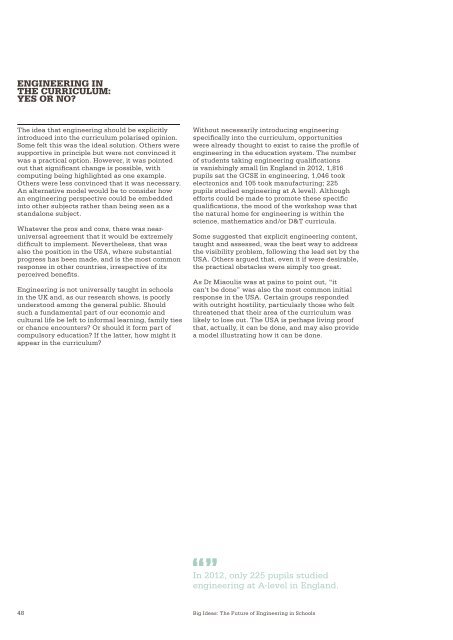BIG IDEAS THE FUTURE OF ENGINEERING IN SCHOOLS
10EyKv
10EyKv
Create successful ePaper yourself
Turn your PDF publications into a flip-book with our unique Google optimized e-Paper software.
<strong>ENG<strong>IN</strong>EER<strong>IN</strong>G</strong> <strong>IN</strong><br />
<strong>THE</strong> CURRICULUM:<br />
YES OR NO?<br />
The idea that engineering should be explicitly<br />
introduced into the curriculum polarised opinion.<br />
Some felt this was the ideal solution. Others were<br />
supportive in principle but were not convinced it<br />
was a practical option. However, it was pointed<br />
out that significant change is possible, with<br />
computing being highlighted as one example.<br />
Others were less convinced that it was necessary.<br />
An alternative model would be to consider how<br />
an engineering perspective could be embedded<br />
into other subjects rather than being seen as a<br />
standalone subject.<br />
Whatever the pros and cons, there was nearuniversal<br />
agreement that it would be extremely<br />
difficult to implement. Nevertheless, that was<br />
also the position in the USA, where substantial<br />
progress has been made, and is the most common<br />
response in other countries, irrespective of its<br />
perceived benefits.<br />
Engineering is not universally taught in schools<br />
in the UK and, as our research shows, is poorly<br />
understood among the general public. Should<br />
such a fundamental part of our economic and<br />
cultural life be left to informal learning, family ties<br />
or chance encounters? Or should it form part of<br />
compulsory education? If the latter, how might it<br />
appear in the curriculum?<br />
Without necessarily introducing engineering<br />
specifically into the curriculum, opportunities<br />
were already thought to exist to raise the profile of<br />
engineering in the education system. The number<br />
of students taking engineering qualifications<br />
is vanishingly small (in England in 2012, 1,816<br />
pupils sat the GCSE in engineering, 1,046 took<br />
electronics and 105 took manufacturing; 225<br />
pupils studied engineering at A level). Although<br />
efforts could be made to promote these specific<br />
qualifications, the mood of the workshop was that<br />
the natural home for engineering is within the<br />
science, mathematics and/or D&T curricula.<br />
Some suggested that explicit engineering content,<br />
taught and assessed, was the best way to address<br />
the visibility problem, following the lead set by the<br />
USA. Others argued that, even it if were desirable,<br />
the practical obstacles were simply too great.<br />
As Dr Miaoulis was at pains to point out, “it<br />
can’t be done” was also the most common initial<br />
response in the USA. Certain groups responded<br />
with outright hostility, particularly those who felt<br />
threatened that their area of the curriculum was<br />
likely to lose out. The USA is perhaps living proof<br />
that, actually, it can be done, and may also provide<br />
a model illustrating how it can be done.<br />
In 2012, only 225 pupils studied<br />
engineering at A-level in England.<br />
48 Big Ideas: The Future of Engineering in Schools


